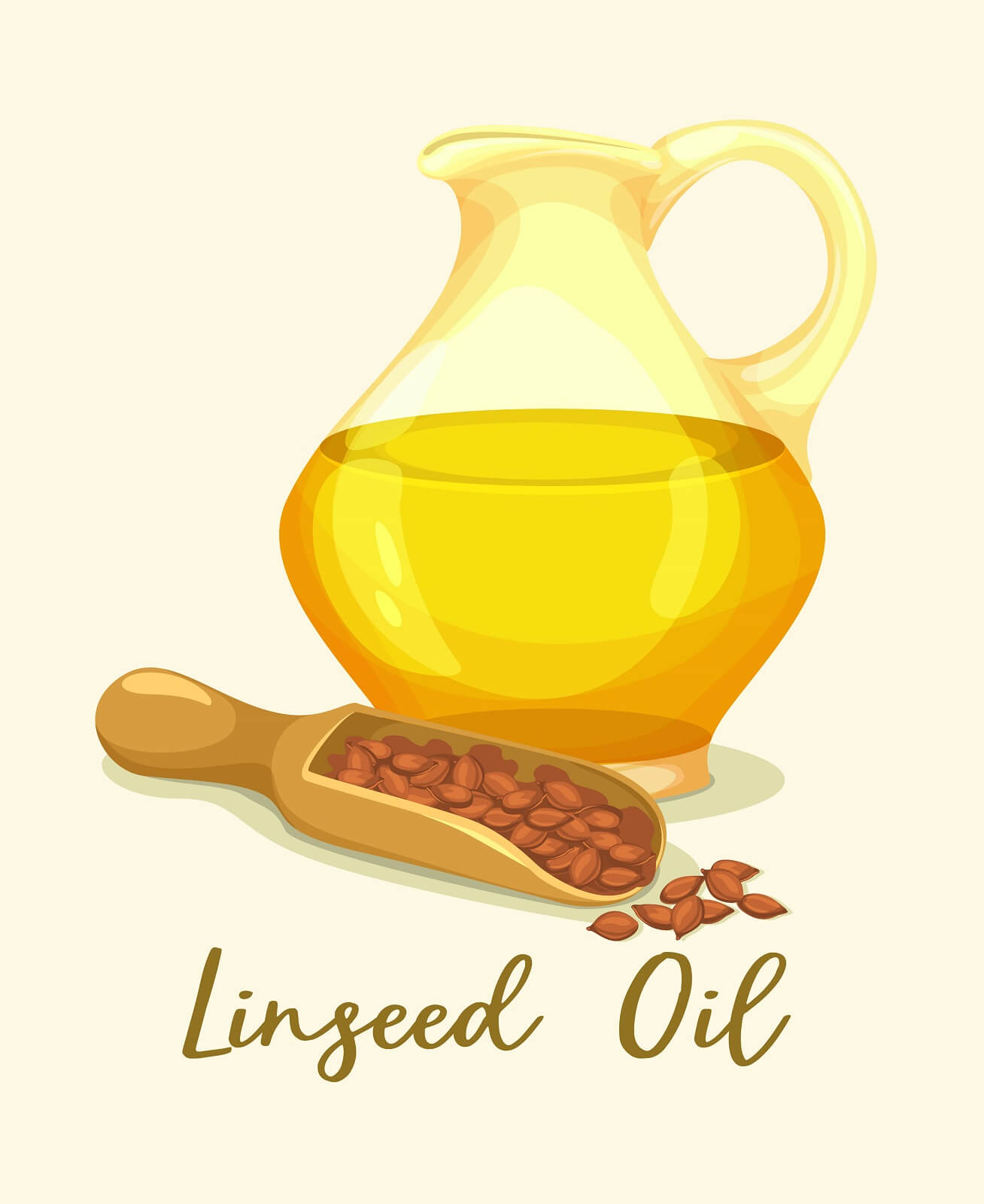
Flaxseed (Linum usitatissimum) is antibacterial if the right preparations of these seeds are used. The whole seeds and powder are not antibacterial; but, an oil or extract of these seeds does fight bacteria. Since studies are limited, it can be inferred from existing research that flaxseed oil or extract will inhibit a wide range of bacteria.
But, it is important to stress that you shouldn’t expect all types of flaxseed to exert an antibacterial effect. Ground or whole flaxseed, not the oil or extract, is not antibacterial; in fact, these preparations have been associated with Salmonella contamination.(source 1)
Research indicates that flaxseed oil and extract is able to fight some very important bacterial pathogens. Even fabric treated with flaxseed oil was able to slightly inhibit Staphylococcus aureus.(source 17) And, in this article we will take an in-depth look at studies that convey this information.
Summary of Flaxseed’s Antibacterial Ability
- Escherichia coli (E. coli)
- Extract effective(source 6)(source 9)
- The oil is more effective than Cefoperazone (Cefobid)(source 7)
- Salmonella
- Extract effective against Salmonella typhimurium(source 6)(source 9)
- Oil effective against Salmonella typhimurium(source 8)
- Listeria
- Extract effective(source 9)
- Cyclolinopeptides in flaxseeds are effective(source 11)
- Staphylococcus aureus (S. aureus) (and MRSA)
- Extract effective against S. aureus,(source 9)
- Oil effective against S. aureus and MRSA(source 16)
Dr. John Herzog (MD)
Dr. John Herzog, a "survival surgeon" from Maine explains what home remedies work best in a crisis situation.
This may be important in the event you require first-aid or are in an emergency situation without easy access to a hospital. Dr. John Herzog has assembled a large collection of home remedies for such scenarios.

Flaxseed’s Effects on Prominent Bacterial Pathogens
Research is somewhat limited at the time of this writing, but there are 3 of the most common bacterial pathogens responsible for the most illnesses, hospitalizations, or deaths in the United States with a good amount of relevant research relating to how flaxseed will impact them.
These three bacterial pathogens are:(source 2)
- Escherichia coli (E. coli)
- Salmonella
- Listeria
E. coli is present in normal intestinal flora, and it is an important member of this microbiome (the microorganisms in a particular environment; i.e., the intestines). Yet, it is a very versatile organism, and can prove deadly when infection occurs.(source 3)
E. coli causes infections of the intestines and outside of the intestines. These infections can include diarrhea, meningitis, sepsis, and urinary tract infections.(source 3)
Salmonella is one of the most commonly found foodborne pathogens. It is a major health concern as it causes 93.8 million foodborne illnesses and 155,000 deaths every year in the world.(source 4)
Stomach flu is the most common Salmonella infection in the world, next in prevalence are bacteraemia (bacteria in the blood) and enteric fever (typhoid fever, and paratyphoid fever). This bacteria is primarily found in diary, eggs, and poultry products.(source 4)
Listeria monocytogenes (commonly called Listeria) that can be found in water or soil. Infection can happen when contaminated food products are consumed. This bacterial pathogen can cause several different diseases; most frequently meningitis, sepsis, rhombencephalitis (an inflammatory disease of the brainstem and cerebellum). It particularly can occur to people with compromised immune systems.(source 5)
Flaxseed’s Effects on E. coli
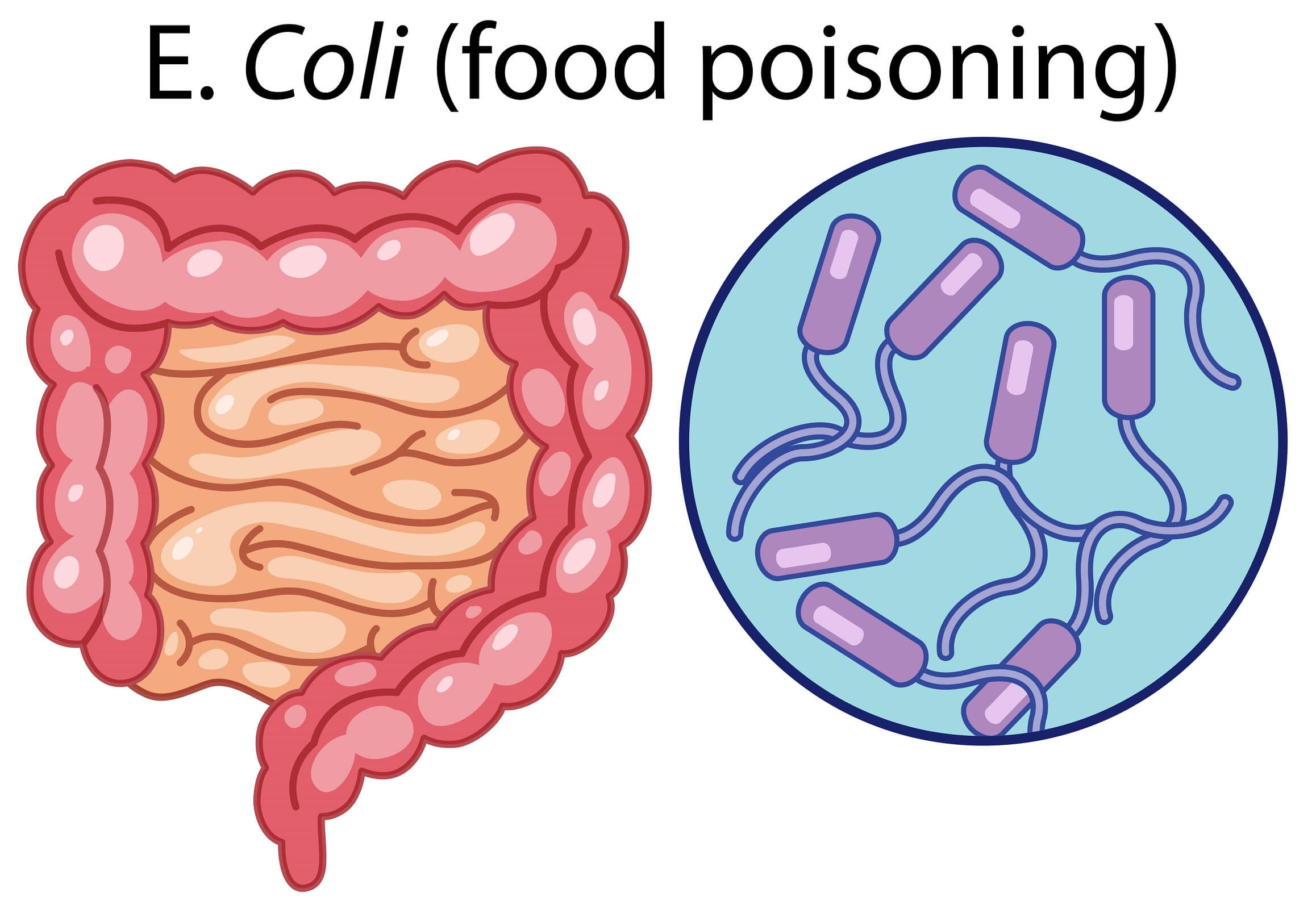
A 2021 study in Systematic Reviews in Pharmacy(source 6) looked at how flaxseed water based and alcohol based extracts would affect E. coli.
The study used a metric known as the "zone of inhibition." (ZOI); This means a test substance is placed on a petri dish and then the dish is inoculated with a microorganism. The area around the drop of the test substance the microorganism does not grow is the ZOI. This indicates how effective at stopping a microbe a substance is.
The study found the following ZOI’s for E. coli with the flaxseed water extract:
- 50 mg/mL concentration: ZOI = 16 mm
- 100 mg/mL concentration: ZOI = 23 mm
The ZOI’s for E. coli with the alcohol based extract were as follows:
- 50 mg/mL concentration: ZOI = 17.5 mm
- 100 mg/mL concentration: ZOI = 25 mm
Thus, this study shows that alcohol based flaxseed extracts are slightly more potent against E. coli than water extract.[lead]
Possibly more interesting is a 2011 study in Inflammopharmacology(source 7) that compared how flaxseed oil would affect E. coli compared to Cefoperazone (a drug used to treat bacterial infections; brand name: Cefobid).
For e.coli flaxseed oil caused a ZOI of approximately 9.16 mm. By comparison Cefoperazone caused a ZOI of approximately 7.00 mm.
Another study also looked at flaxseed oil against E. coli. This study was published in 2021 in Applied Sciences.(source 8) This research looked at how three different flaxseed oils affected E. coli. All three of these oils were extracted via cold pressing.
The study found the minimum inhibitory concentration (MIC) and minimum bactericidal concentration (MBC) of flaxseed oil against E. coli.
MIC is defined as: the lowest concentration of an antimicrobial that will inhibit the visible growth of a microorganism after overnight incubation...
(source 10)
MBC is defined as: the lowest concentration of [an] antimicrobial [substance] that will prevent the growth of an organism after subculture on to antibiotic-free media.
(source 10)
The study reported the average MIC and MBC for these three oils on E. coli was:
- Average MIC: 1.166 mg/mL
- Average MBC: 2.333 mg/mL
A 2017 study in the Journal of Microbiology and Biotechnology(source 9) looked at how flaxseed alcoholic extract would affect E. coli. The study found, after 12 hours incubation with a concentration of 1% flaxseed extract, E. coli CFUs (colony forming units) dropped by 31.4%.
Flaxseed’s Effects on Salmonella
The 2021 study in Systematic Reviews in Pharmacy(source 6) also found how flaxseed water based and alcohol based extracts would affect Salmonella typhimurium (S. typhimurium). Again, a ZOI was found for the extracts.
The study found the following ZOI’s for S. typhimurium with the flaxseed water extract:
- 50 mg/mL concentration: ZOI = 17 mm
- 100 mg/mL concentration: ZOI = 24 mm
The ZOI’s for S. typhimurium with the alcohol based extract were as follows:
- 50 mg/mL concentration: ZOI = 19 mm
- 100 mg/mL concentration: ZOI = 26 mm
The 2021 study in Applied Sciences(source 8) also looked at how three flaxseed oils would affect Salmonella typhimurium.
The study reported the average MIC and MBC for these three oils on this bacteria was:
- Average MIC: 1.333 mg/mL
- Average MBC: 2.666 mg/mL
The 2017 study in the Journal of Microbiology and Biotechnology(source 9) also looked at how flaxseed alcoholic extract would affect Salmonella typhimurium. The study found, after 12 hours incubation with a concentration of 1% flaxseed extract, CFUs (colony forming units) of this bacteria dropped by 13.1%.
Flaxseed’s Effects on Listeria
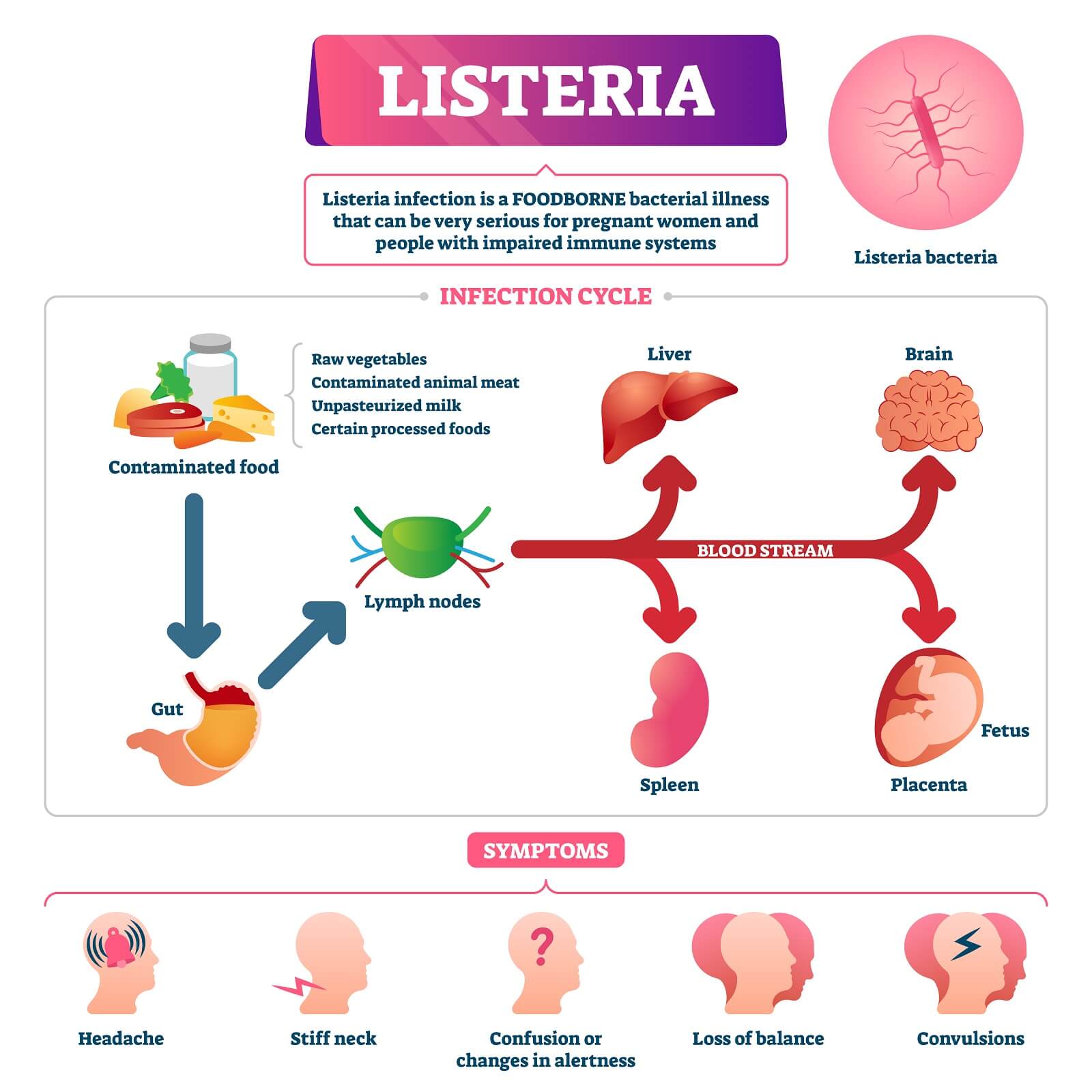
Listeriosis is a serious infection caused by the germ Listeria monocytogenes. People usually become ill with listeriosis after eating contaminated food. The disease primarily affects pregnant women, newborns, older adults, and people with weakened immune systems. It’s rare for people in other groups to get sick with Listeria infection.(source 18)
At the time of this article’s writing, there was little information regarding the antibacterial properties of flaxseed for Listeria bacteria. Let’s look at two different studies on this topic.
The 2017 study in the Journal of Microbiology and Biotechnology(source 9) also looked at how flaxseed alcoholic extract would affect Listeria monocytogenes. The study found, after 12 hours incubation with a concentration of 1% flaxseed extract, CFUs (colony forming units) of this bacteria dropped by 19.9%.
A study published in 2022 in Food Chemistry (source 11) looked at how cyclolinopeptides from flaxseed oil would impact Listeria. The study found that 100 to 200 micromoles of these substances had antibacterial effects on Listeria monocytogenes.
14 different cyclolinopeptides in fresh flaxseed meal has approximately 0.645 mg/g of cyclolinopeptides in it. After 48 months of storage, this amount is reduced to approximately 0.583 mg/g.(source 13)
There are several different types of cyclolinopeptides, thus for simplicity we will just use Cyclolinopeptide I(source 12) to approximate the molar mass of the blend of peptides. If we do this we arrive at 213.68 mg for 200 micromoles of Cyclolinopeptide I.
Thus it would take 331.28 g of flaxseed meal to get the 200 micromoles of cyclolinopeptides from the flaxseed meal.
Flaxseed oil has approximately 0.8 mg/g of cyclolinopeptides in it;(source 14) thus it would take about 267.1 g of flaxseed oil to get 200 micromoles cyclolinopeptides.
So as a result, flaxseed oil and flaxseed is not rich enough in cyclolinopeptides to produce a concentration of them that can effectively stop Listeria monocytogenes.
Claire Goodall’s Amazing Guide
Clair Goodall is a bee-obsessed, natural medicine convert from Minnesota (USA). And, she does keep bees!
Clair has created 350+ page book documenting how to replace the toxic products and medications in your home with healthier, all-natural alternatives.

Flaxseed Fights Staphylococcus aureus & MRSA
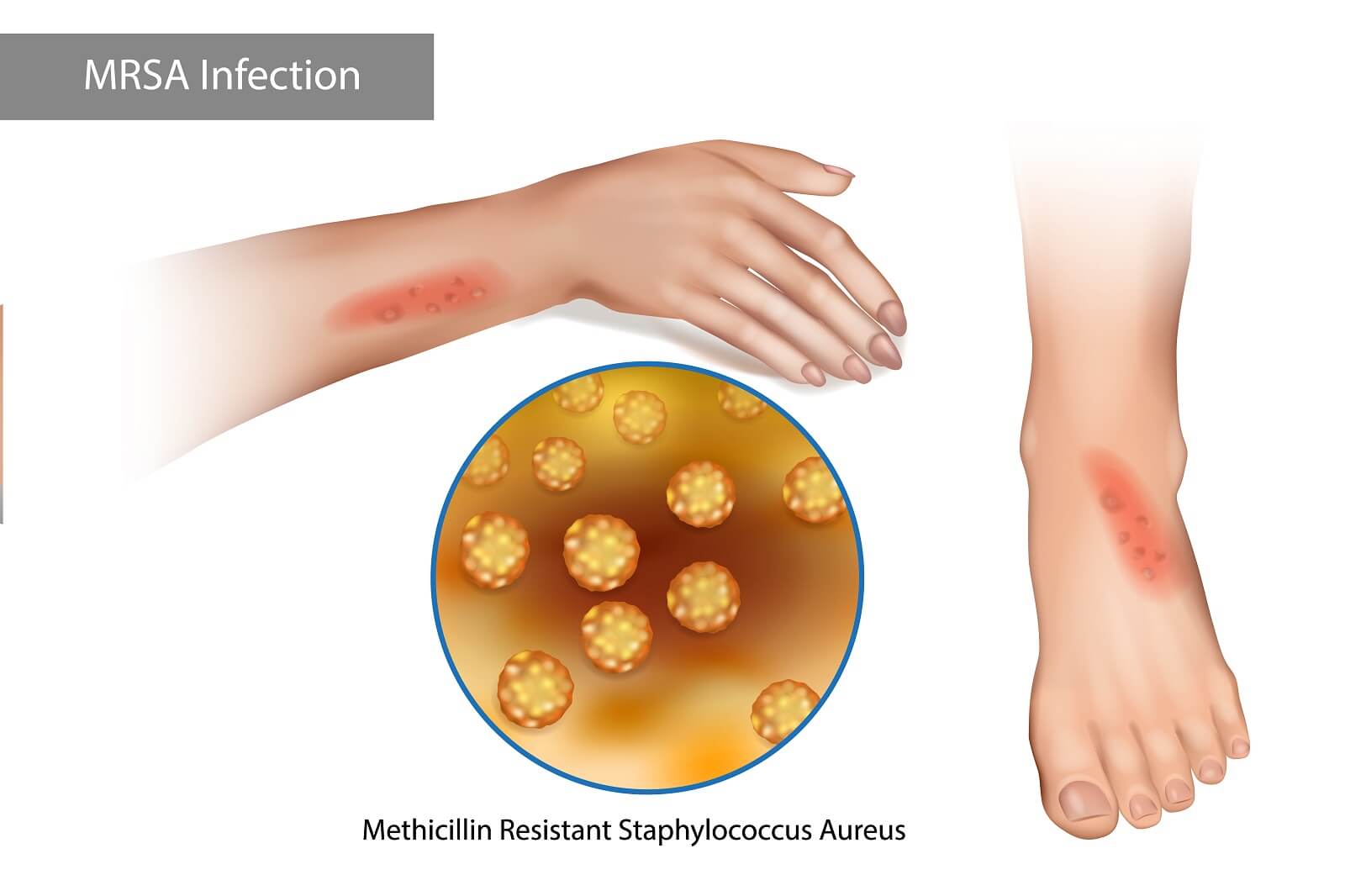
The symptoms of a MRSA infection depend on the part of the body that is infected. For example, people with MRSA skin infections often can get swelling, warmth, redness, and pain in infected skin. In most cases it is hard to tell if an infection is due to MRSA or another type of bacteria without laboratory tests...(source 18)
Staphylococcus aureus (S. aureus) is a bacteria that can normally be present in healthy people. Although this bacteria doesn’t cause infections on healthy skin, it can become a problem when it enters the body. It is capable of causing a wide range of infections--from minor skin infections to serious diseases such as sepsis, bacteremia (bacteria in the bloodstream), endocarditis (inflammation of the inner lining of the heart chambers and valves), meningitis, and pneumonia.(source 15)
Methicillin-resistant S. aureus (MRSA) is a genetically different type of S. aureus that is resistant to many antibiotics such as methicillin, penicillin, oxacillin, cloxacillin, cefazolin, cefoxitin, and other common antibiotics.
When S. aureus becomes immune to any synthetic antibiotic, it enhances its danger; and can cause serious disease and infection. Hence, natural medicine can be crucial for this reason, as herbs work to hinder and kill bacteria in ways synthetic antibiotics do not.
Thus, since MRSA is sensitive to flaxseed oil and extract, it may make a great topical oil in which to dilute other essential oils or herb in (to mitigate their strong effects and prove gentler to the skin) to create a great solution for an infection when prescription antibiotics have failed.
Let’s take a look at two studies that documented how S. aureus is sensitive to flaxseed.
The 2017 study in the Journal of Microbiology and Biotechnology(source 9) also looked at how flaxseed alcoholic extract would affect S. aureus. The study found, after 12 hours incubation with a concentration of 1% flaxseed extract, CFUs (colony forming units) of this bacteria dropped by 29.4%.
A 2016 study in the Iraqi Journal of Science(source 16) looked at how flaxseed oil would affect S. aureus and MRSA.
The following ZOIs were found for flaxseed oil:
- For S. aureus: approximately 1.77 cm
- For MRSA: approximately 1.55 cm
A 2018 study in Materials Today: Proceedings(source 17) looked at how fabric treated with flaxseed oil would exert an antimicrobial effect against S. aureus. To do this, flaxseed oil was applied to the fabric and a squeezing roller was used to remove the excess oil. Finally, the fabric was dried for 72 hours at room temperature.
Interestingly enough, the flaxseed oil treated fabric produced a ZOI against S. aureus of 3 mm, whereas the untreated fabric did not cause any ZOI.
Thus, we can conclude that research shows that flaxseed oil will fight S. aureus and MRSA, making it a valuable antibacterial natural alternative.
Flaxseed Side Effects & Guidelines
Flaxseed is generally safe, but there are some side effects to be aware of. The mucilage in it might interfere with the absorption of medications. And, you may want to limit small children’s intake of it because it does result in a little cyanide being put into the body due to the presence of cyanogenic glycosides (these chemicals are found in other plants and are not that unusual).
Aside from the possibility of constipation if you do not drink enough water when you take it, it is probably unlikely that adults will have problems if they consume reasonable amounts.
But, Herbsey does have an entire article on the side effects of flaxseed, which goes into greater detail. If you’d like to learn more, and get a fuller understanding about this helpful food, you can check it out:
A Natural Digestive System Supplement that Helps
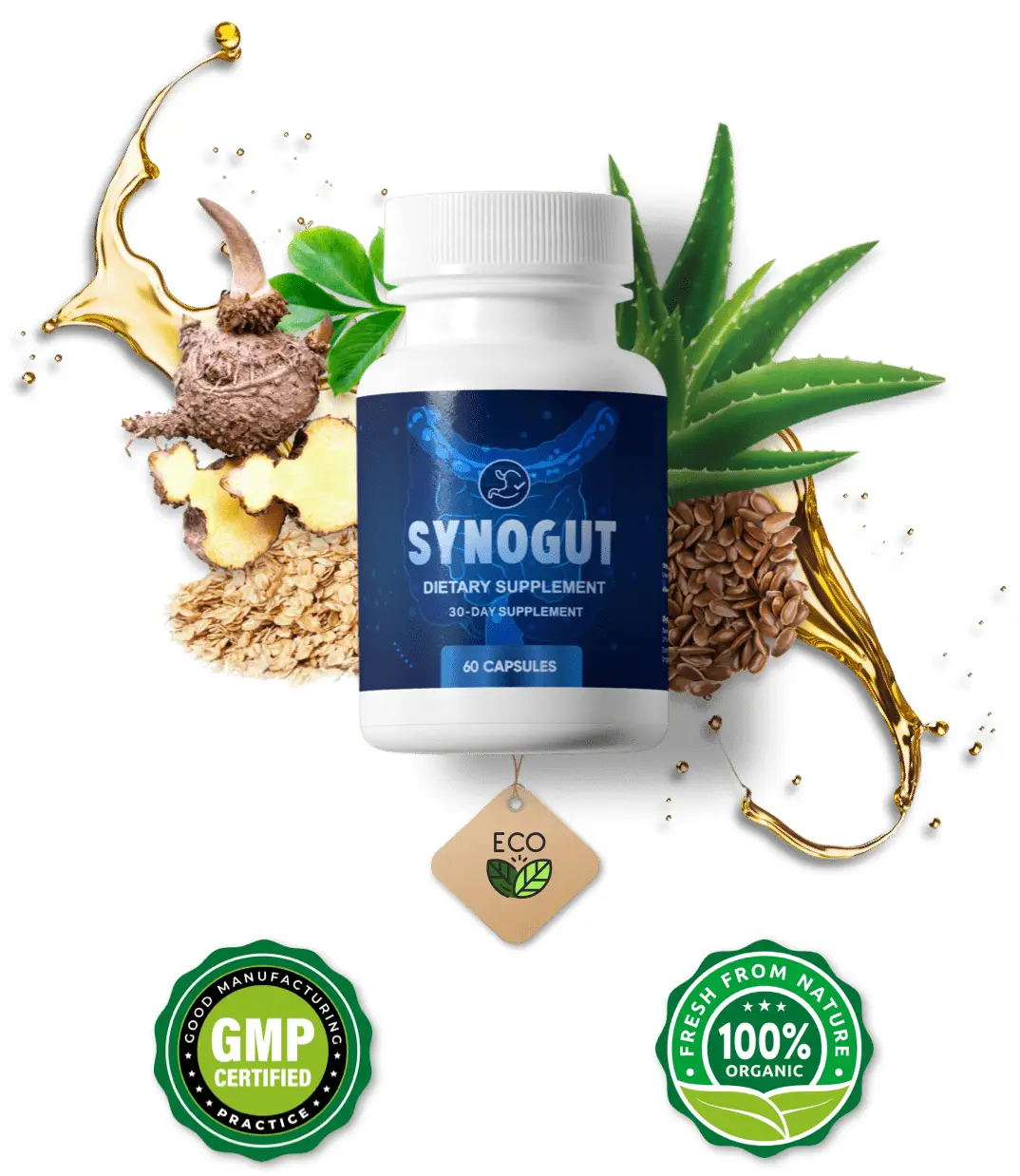
If you have been struggling with digestive problems like constipation, you should know about Samuel Bart. Mr. Bart lives with his wife, Alma, in Nashville, Tennessee.
Mr. Bart has always had a passion for plants and how to use them medicinally. He went on to research some of the most effective ways that could help people support a healthy digestive system.
To this end, Mr. Bart developed a product he calls “SynoGut.”
Every capsule of this supplement is made in the USA, in a FDA approved, and GMP certified, facility under sterile, strict, and precise standards. Synogut capsules are non-GMO. You can rest assured that they do not contain any dangerous stimulants or toxins, and more importantly, they are not habit forming.
His proprietary blend blend contains the following ingredients:
- Psyllium husk
- Bentonite clay
- Black walnut hull
- Oat bran
- Flaxseed
- Prune fruit
- Aloe vera leaf
- Lactobacillus acidophilus (a probiotic bacteria)
- Apple fruit pectin
- Glucomannan root
If this is not the first time you have had constipation, you might benefit from the power these natural items can provide. And, if you have had prolonged constipation, utilizing a supplement like Mr. Bart’s could help you become more regular—without an arsenal of prescription drugs.
Many people have tried synthetic drugs to solve their constipation issues; and if these didn’t work, it may be hard to invest in a natural remedy like SynoGut. To this end, Mr. Bart offers a 60 day, full refund guarantee on his supplement.
If you decide to invest in Mr. Bart’s supplement, and are not satisfied with the results, you can quickly request a refund. SynoGut will promptly refund your purchase; ensuring there is no risk to give Mr. Bart a chance.
SynoGut is sold via the large online retailer ClickBank—a company based in Boise Idaho, USA. ClickBank sells products across the world, and ensures you can get a refund if you are not satisfied with SynoGut’s results.
If you are in a situation where you have “tried everything,” SynoGut is worth the quick purchase and a solid test drive. If you would like to learn more about Samuel Bart’s SynoGut supplement, you can do so at the SynoGut website.
About the Author
Geoff Kent is a natural medicine enthusiast who has been researching and writing about natural medicine since 2008. Geoff is primarily a web developer, but also researches and authors written and video content about natural health. Geoff has a bachelor’s degree in Management Information Systems from the University of Northern Iowa.
More on Geoff KentImportant Disclosures & Disclaimers
It is important to use the information you find on Herbsey.com in the right way. Also for legal reasons, these disclaimers and disclosures are necessary. For further information about each, feel free to click the link provided to the page on this website that provides more information.
Medical Disclaimer
The information on this website is not a prescription for anyone. This information is for informational or educational purposes only, and is not a substitute for professional medical advice or consultations with healthcare professionals.
Advertisement Disclosure
Some of the links provided on this article and website are affiliate links. If you purchase a product after clicking on these links, Herbsey.com will earn a commission. Herbsey.com promotes various products through advertisement and text links. For more information: Our Advertisements.







